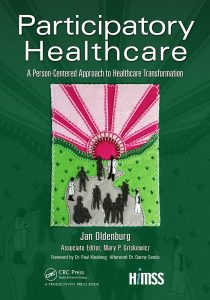 Participatory Healthcare: A Person-Centered Approach to Healthcare Transformation, edited by Jan Oldenburg with Associate Editor Mary Griskewicz, could become the defining textbook of our field – the new cornerstone of our movement.
Participatory Healthcare: A Person-Centered Approach to Healthcare Transformation, edited by Jan Oldenburg with Associate Editor Mary Griskewicz, could become the defining textbook of our field – the new cornerstone of our movement.
Ten years ago “Doc Tom” Ferguson was working on our founding document, the “e-Patient White Paper” e-Patients: How they can help heal healthcare, when he died unexpectedly. His followers finished and published it in 2007, then formed our Society and Journal in 2009. For years since then I, for one, have felt the White Paper needed to be updated with a broader body of anecdotes and – perhaps more important – with a conceptual framework around which we and all of medicine could organize our thoughts and advance our movement. This is that book.
Essays and anecdotes
Editor Jan Oldenburg says she wondered if it should have been two books, but I’m glad it’s not, because the two sections are distinct yet usefully and potently cross-linked.
Section 1 is eight essays by recognized leaders in different aspects of medicine, from clinical practice to economics and health IT, highlighting new models of care, acute and chronic, in-hospital and out, involving patients and caregivers in innovative ways. Section 2 is an equally important set of 27 real world stories of patients whose cases and outcomes were clearly altered by the presence or absence of a participatory approach.
Each section is important for a different reason. The essays are important for observers of medicine, e.g. academics, whose thinking is organized around intellectual domains such as economics or technology. The stories are essential in a different way: they are the proof, the “anomalies” that are necessary to change the paradigm in a scientific field.
Facts can kindle a scientific revolution
In the foreword, Dr. Paul Kleeberg, former HIMSS Board Chair and Family Physician, suggests, “You hold in your hands a book that contains the keys to transforming our healthcare system from one in which patients are receivers of care to one in which they are collaborators in care.” The afterword, by SPM co-founder and current chair Dr. Danny Sands, says the book shows “that despite the challenges, there are examples of success with patient-centered healthcare innovation all over the world.” Each of these leaders is correctly pointing to the power of these stories in changing the culture of medicine, kindling a scientific revolution.
I don’t say that lightly. In his landmark 1962 book The Structure of Scientific Revolutions, Thomas Kuhn introduced paradigms and anomalies in a model of how scientific fields realize their view is incomplete and must change. The paradigm is an agreement in the field about what’s important and how things work, which leads to predictable results. The field is in trouble when facts come along that the paradigm didn’t predict. He called such facts anomalies.
The most famous example was the Copernican Revolution, where the erratic behavior of Mars in the sky was an “anomaly” that demanded we give up our view of Earth as the center of the solar system. Structure showed how in science after science, when there were too many anomalies, the paradigm had to change.
After five hundred speeches and meetings in fifteen countries, I assert that this is the state of our field today: the core thing holding back practices and policies of participatory medicine is the demonstrably outdated belief that patients don’t have anything clinically useful to offer, so it’s all about the doctors and scientists. If that’s the paradigm, then all 27 of these patient stories are anomalies that must be answered.
The case for a new view
Anomalies may prove that the paradigm’s out of date, but they don’t provide a new view. That’s where the essays come in.
Skeptics who think consumers/patients can’t do anything useful will benefit from economist Jane Sarasohn-Kahn’s essay on the DIY health consumer; skeptics who think medicine’s all about the biology will benefit from the essay by Catherine Serio and Susan Butterworth on behavior change – a demonstrably valuable intervention that few providers in my life have ever talked about, largely because the insurance industry doesn’t pay people to help me with it. So it is with each of the eight essays.
Connect the dots and a picture emerges
Not surprisingly, both editors are members of our Society, as are the authors of most of the essays and about half of the patients mentioned. Interestingly, as the editors collected the content they weren’t aware of this.
It’s important at this stage of a movement to connect such dots, which is another thing this book does well, to help students see new patterns: wisely and beautifully, the essays and stories are linked. Each essay is followed by a list of which of the 27 stories illustrate its points – an editorial extra so valuable in a textbook, helping students apply the essay’s lessons to the real world, and conversely see in the stories the more abstract principles that can lead enlightened academics, practitioners, and policymakers to advance the field.
This book is a fitting continuation of Tom Ferguson’s legacy: by reframing the discussion around the role of patients in healthcare, it makes the case for a world-changing paradigm shift in our approach to patient care. Participatory Healthcare provides exactly what we need: conceptual essays and pragmatic stories that demand to be heard. I very much hope you’ll read it, from cover to cover.
Save 20% on Participatory Healthcare by downloading this flyer and using the promo code. participatory-healthcare-flyer-final\

